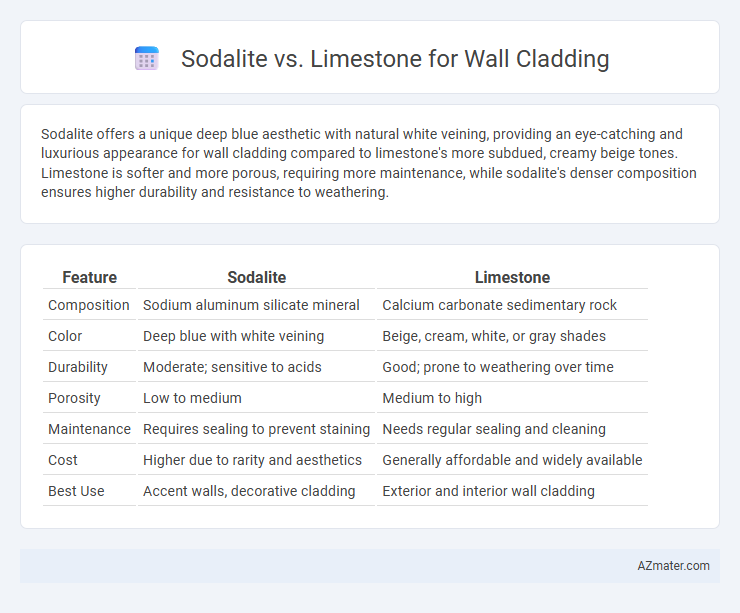Sodalite offers a unique deep blue aesthetic with natural white veining, providing an eye-catching and luxurious appearance for wall cladding compared to limestone's more subdued, creamy beige tones. Limestone is softer and more porous, requiring more maintenance, while sodalite's denser composition ensures higher durability and resistance to weathering.
Table of Comparison
| Feature | Sodalite | Limestone |
|---|---|---|
| Composition | Sodium aluminum silicate mineral | Calcium carbonate sedimentary rock |
| Color | Deep blue with white veining | Beige, cream, white, or gray shades |
| Durability | Moderate; sensitive to acids | Good; prone to weathering over time |
| Porosity | Low to medium | Medium to high |
| Maintenance | Requires sealing to prevent staining | Needs regular sealing and cleaning |
| Cost | Higher due to rarity and aesthetics | Generally affordable and widely available |
| Best Use | Accent walls, decorative cladding | Exterior and interior wall cladding |
Introduction to Sodalite and Limestone
Sodalite is a deep blue tectosilicate mineral prized for its rich color and unique patterns, making it a popular choice for decorative wall cladding in both residential and commercial spaces. Limestone, a sedimentary rock composed primarily of calcite, offers a more neutral tone with a natural, earthy texture that complements various architectural styles. The contrasting aesthetics and physical properties of sodalite and limestone influence their suitability and maintenance requirements in wall cladding applications.
Geological Origins and Composition
Sodalite, a blue tectosilicate mineral rich in sodium, forms primarily in nepheline syenites through igneous processes, featuring a composition rich in sodium, aluminum, chlorine, and oxygen. Limestone is a sedimentary rock composed mainly of calcite (calcium carbonate), formed from the accumulation of marine organism shells and skeletons in shallow, warm marine waters. The fundamental geological difference lies in sodalite's igneous origin with a crystalline structure versus limestone's sedimentary origin with a carbonate matrix.
Aesthetic Differences: Color and Texture
Sodalite wall cladding features deep blue tones with white veining, offering a bold and striking appearance that enhances modern and luxurious interiors. Limestone displays a softer, more neutral palette ranging from creamy beige to warm gray, providing a subtle and natural texture ideal for classic or rustic designs. The smooth, fine-grained texture of limestone contrasts with the crystalline, patterned surface of sodalite, creating distinctive visual impacts for different architectural aesthetics.
Durability and Longevity
Sodalite offers superior durability for wall cladding due to its dense crystalline structure and resistance to weathering, making it ideal for both interior and exterior applications. Limestone, while aesthetically pleasing, is more porous and susceptible to erosion and acid rain, which can compromise its longevity in harsh environments. Choosing sodalite ensures a longer-lasting, low-maintenance cladding solution with enhanced resistance to staining and wear.
Installation Process and Techniques
Sodalite wall cladding requires precision cutting and careful handling due to its dense, crystalline structure to prevent chipping during installation, often utilizing adhesive or mechanical anchors suited for natural stone. Limestone, being softer and more porous, allows easier cutting with standard masonry tools and typically uses mortar or mechanical fasteners for secure attachment, adapting well to various substrate types. Both materials benefit from expert surface preparation and sealing processes to enhance durability and aesthetic appeal in wall cladding applications.
Maintenance and Cleaning Requirements
Sodalite wall cladding requires minimal maintenance with occasional dusting and a gentle wash using pH-neutral cleaners to preserve its vibrant blue hues, making it ideal for indoor applications. Limestone, being more porous, demands frequent sealing and careful cleaning with mild detergents to prevent staining and surface erosion, especially in high-traffic areas. Both materials benefit from regular inspections to address potential damage, but Sodalite generally offers superior durability with less intensive upkeep.
Environmental Impact and Sustainability
Sodalite and limestone differ significantly in their environmental impact and sustainability for wall cladding, with sodalite being a rarer, more energy-intensive mineral to extract and process, leading to a larger carbon footprint. Limestone, abundant and widely quarried, offers a more sustainable option due to its natural recyclability and lower energy requirements during extraction and finishing. Choosing limestone can contribute to reducing environmental degradation and supports sustainable building practices by minimizing resource depletion.
Cost Comparison
Sodalite wall cladding typically costs more due to its rarity and unique deep blue color, ranging from $15 to $30 per square foot, whereas limestone is more affordable, averaging between $10 and $25 per square foot. Installation expenses for sodalite may also be higher because of its hardness and specialized handling requirements. Limestone offers a cost-effective solution with easier workability and widespread availability, making it suitable for budget-conscious projects.
Popular Applications in Wall Cladding
Sodalite is favored for wall cladding in luxury residential and commercial spaces due to its striking deep blue color and unique veining, providing an artistic and modern aesthetic. Limestone is widely used in traditional and contemporary architecture for its natural beige to gray tones, durability, and ease of maintenance, making it ideal for both interior and exterior wall cladding. Both materials cater to popular applications in high-end hospitality, office buildings, and feature walls, with sodalite offering vibrant visual appeal and limestone delivering timeless elegance.
Choosing the Best Stone for Your Project
Sodalite offers a striking deep blue hue with unique white veining, ideal for creating bold, artistic wall cladding that stands out in modern interiors. Limestone provides a warm, neutral palette with subtle textures, making it a versatile choice that complements both traditional and contemporary designs while delivering excellent durability. Selecting the best stone depends on project requirements such as color preference, maintenance needs, and environmental exposure, with Sodalite suited for statement walls and Limestone favored for timeless elegance and ease of upkeep.

Infographic: Sodalite vs Limestone for Wall Cladding
 azmater.com
azmater.com